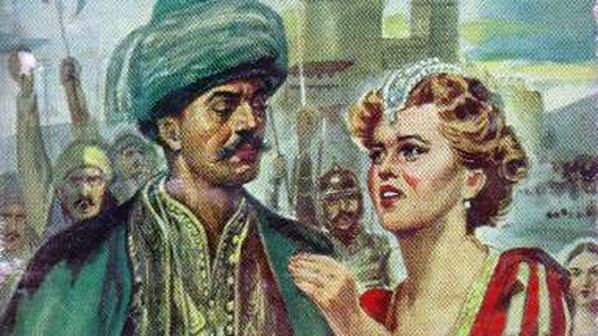Monarch Mehmet IV Preceded by Bakirci Ahmed Pasha | Name Gazi Pasha | |
 | ||
Succeeded by Sultanzade Mehmed Pasha | ||
Preceded by Ermeni Suleyman Pasha | ||
Gazi Hüseyin Pasha
Gazi Hüseyin Pasha ("Hüseyin Pasha the Warrior"; died 1659), also known as Deli Hüseyin Pasha ("the Mad") or Sarı Hüseyin Pasha ("the Blonde") or Baltaoğlu Hüseyin Pasha ("of the Axe"), was an Ottoman military officer and statesman. He was governor of Egypt (1635–1637), Kapudan Pasha in the 1630s, and briefly Grand Vizier in 1656.
Contents
Background
Hüseyin was of Turkish origin and was born in Yenişehir near Bursa in northwest Anatolia. Other than that, little is known about his early days in Constantinople, the Ottoman capital. During the reign of Murat IV, he was a member of palace staff. The shah of Iran had sent Murat IV a prestigious gift, a bow which was reputed as being undrawable. Hüseyin attracted attention when he easily drew the bow. After winning sultan's appreciation, he was promoted to various posts: chief stable man, governor of Silistria in (now in modern Bulgaria), beylerbey (high governor) of Egypt, beylerbey of Anatolia, Kapudan Pasha, etc. He participated in campaigns around Baghdad in modern Iraq and Yerevan (now in modern Armenia). During the reign of Ibrahim I, he served in various European provinces as a governor, and in 1646, he became the governor of Chania, Crete (now in Greece).
Governor of Egypt
Hüseyin Pasha was appointed the governor of Egypt Eyalet in 1635, succeeding Bakırcı Ahmed Pasha and serving until 1637. He was reportedly a cruel and violent governor who murdered for sport. From the very first day of his arrival in Egypt, when he confiscated his finance minister and advisors' temporary tents for his own, Hüseyin Pasha began a series of actions that made him widely disliked by the local populace. He brought with him to Egypt a large number of Druzes, who committed robberies in Cairo, the capital, and his men extorted money from the locals for an upcoming feast celebrating his arrival. Hüseyin Pasha was also involved in stealing wealthy locals' inheritances, so much so that it became a reliable way to exact revenge on an enemy by reporting to the Pasha that he or she had received an inheritance from a relative. He also often reportedly rode a horse through crowds of people and animals, swinging a sword, for recreation. Each month, he forced locals to trade in their bullion coin for adulterated metal and sent bureaucrats and officials to remote locations for sport. During his rule, he had over 1,200 people executed, not including those that he killed by his own hand.
Despite his cruelty, Hüseyin Pasha was an able commander and leader of the local troops, which was a particularly difficult task in Egypt. He was attentive to government details in the divan and successfully decreased robbery and burglary in Egypt.
After his dismissal from office in 1637, sultan Murad IV demanded of him an audit of the Egyptian provincial treasury and public revenues, and for him to pay what he owed to the treasury. When he refused, the kaymakam (acting governor) who replaced him until the arrival of his successor jailed Hüseyin, and he was freed only when he paid a large sum.
Cretan War
Conquest of the Aegean island Crete from Venice was uncharacteristically trying for Ottoman Empire. While the Ottoman Empire was in stagnation, the military and naval technology of the Europeans was on the rise. Although Chania, a major Cretan city, had been captured in 1645, the rest of the island, especially Heraklion, was able to resist the Ottomans. The Ottoman Empire was unable to send reinforcements to Crete because the strait of Dardanelles (Çanakkale) was blocked by the Venetian navy. (see Cretan War (1645–1669))
Thus, the Ottoman army in Crete was deadlocked. Even under these circumstances, Hüseyin captured several forts including Rethymno and laid a siege to Heraklion. He also reconstructed many buildings and the fort of Chania. Sultan Mehmet IV promoted him to be the grand vizier on 28 February 1656.
However he never exercised the post. Long before Huseyin's return to Constantinople, the sultan changed his mind and appointed Hüseyin's rival Zurnazen Mustafa Pasha as grand vizier on 6 March 1656 (although Zurnazen's term was even shorter than that of Hüseyin).
Later years
Hüseyin was assigned to be the beylerbey (governor) of Rumeli, a post inferior to that of grand vizier, but superior to those of the beylerbeys of other provinces. Nevertheless, the new grand vizier Köprülü Mehmet Pasha was afraid of Hüseyin's prestige. He called Hüseyin to Constantinople and persuaded the sultan to jail and later to execute Hüseyin in 1659.
